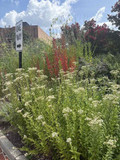Gaura longiflora (G. filiformis) - LARGE-FLOWERED GAURA
Short-lived/biennial native wildflower, valuable for long and late blooming period and fast establishing
Leaf rosettes in the first year, blooms the second year and persists by re-seeding.
Unique 6'+ airy and wiry structure moves in the wind.
Small white-pink flowers attract native bees and small birds.
Blooming Time: July-October
Size: 6’ high x 2’ wide, in ideal conditions can reach height of 9'
USDA Zones: 4 to 8
Culture: Full sun, partial sun, average soils, preferably not heavily amended
Moisture Needs: medium-wet, medium, medium-dry to dry
Origin: central parts of the USA, from Texas up North. can be found in prairies, openings, often in early stages of natural succession. Fast growing. See the BONAP distribution map.
Deer/Rabbit Resistant: yes/yes
Attracts Butterflies or Pollinators: no / long-tongued bees, bumblebees
Attracts Hummingbirds: no, and attracts small birds
Pot Size: 3.5" x 4" perennial pot (1.22 pt/580 ml)
Plant combinations: Best in naturalistic setting and prairie-inspired plantings, pollinator or bird gardens. Plant in the background due it's height. or mix with very tall plants. Good to combine it's fine structure with more coarse ones of Echinacea, Rudbeckia, Silphium, Veronicastrum or tall Coreopsis, Liatris or with bigger grasses (Panicum, Sorghastrum etc.).
Pictures copyright: Sam Bahr, University of Maryland

Gaura longiflora (G. filiformis) - LARGE-FLOWERED GAURA
Short-lived/biennial native wildflower, valuable for long and late blooming period and fast establishing
Leaf rosettes in the first year, blooms the second year and persists by re-seeding.
Unique 6'+ airy and wiry structure moves in the wind.
Small white-pink flowers attract native bees and small birds.
Blooming Time: July-October
Size: 6’ high x 2’ wide, in ideal conditions can reach height of 9'
USDA Zones: 4 to 8
Culture: Full sun, partial sun, average soils, preferably not heavily amended
Moisture Needs: medium-wet, medium, medium-dry to dry
Origin: central parts of the USA, from Texas up North. can be found in prairies, openings, often in early stages of natural succession. Fast growing. See the BONAP distribution map.
Deer/Rabbit Resistant: yes/yes
Attracts Butterflies or Pollinators: no / long-tongued bees, bumblebees
Attracts Hummingbirds: no, and attracts small birds
Pot Size: 3.5" x 4" perennial pot (1.22 pt/580 ml)
Plant combinations: Best in naturalistic setting and prairie-inspired plantings, pollinator or bird gardens. Plant in the background due it's height. or mix with very tall plants. Good to combine it's fine structure with more coarse ones of Echinacea, Rudbeckia, Silphium, Veronicastrum or tall Coreopsis, Liatris or with bigger grasses (Panicum, Sorghastrum etc.).
Pictures copyright: Sam Bahr, University of Maryland






